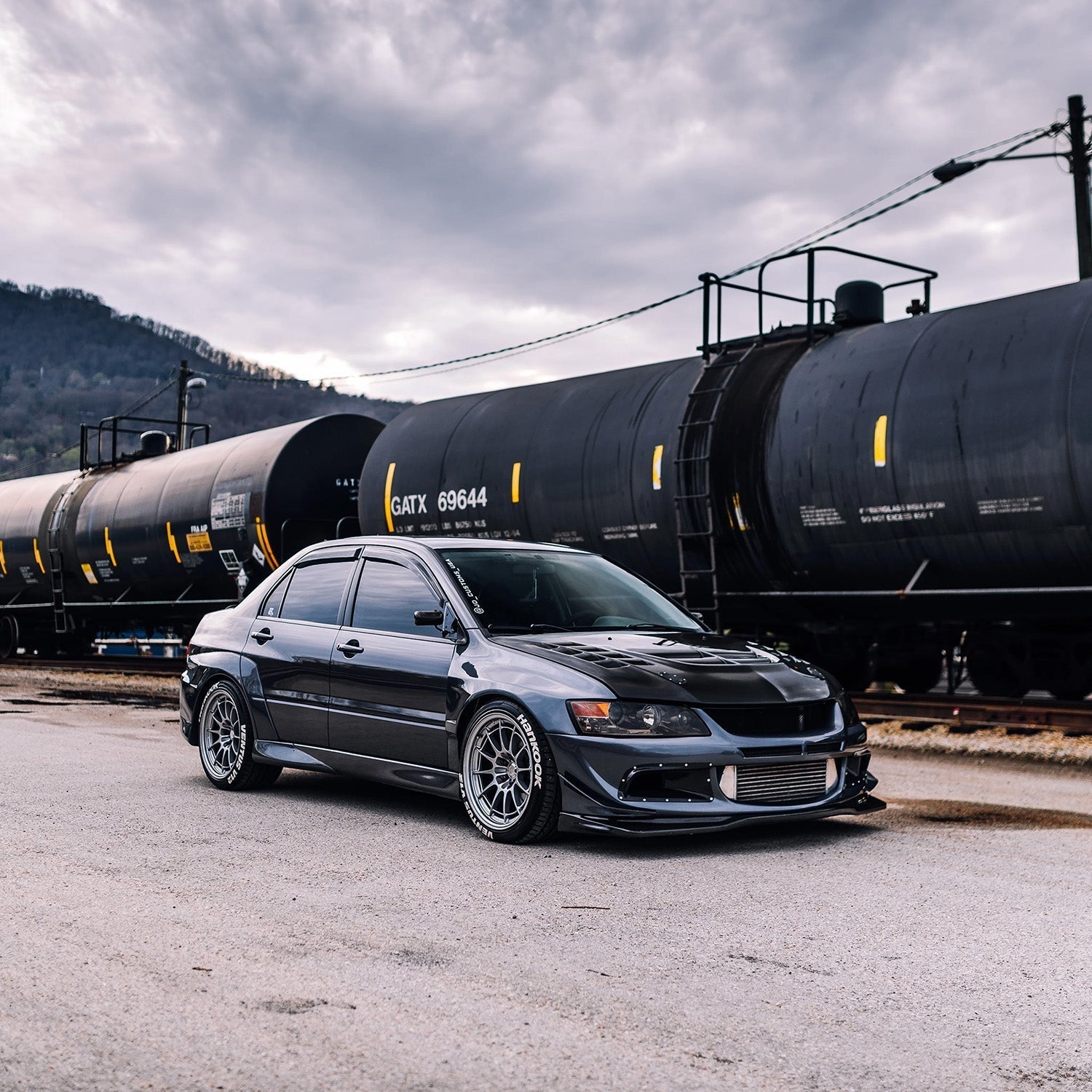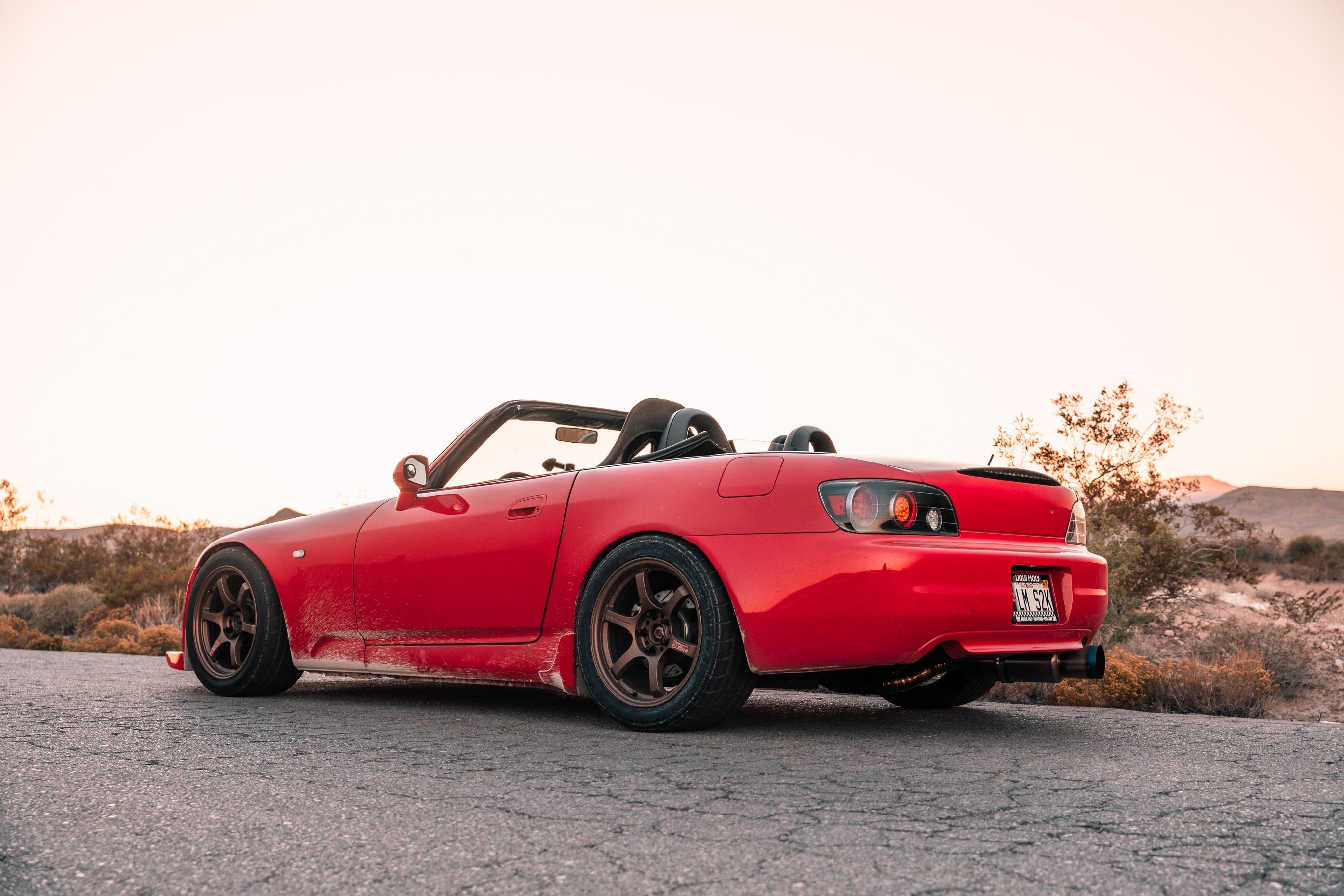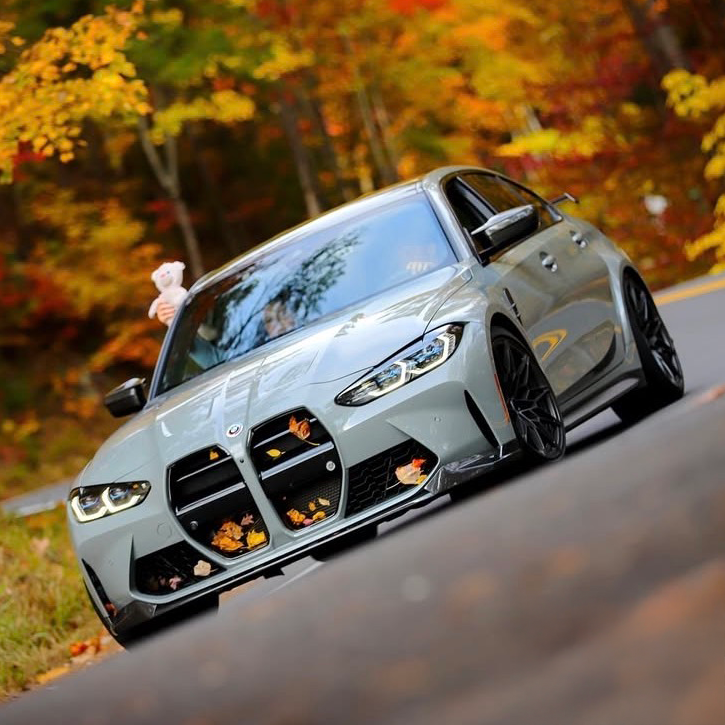Mitsubishi Lancer Evolution 8 vs. 9: Key Differences Explained
The Mitsubishi Lancer Evolution, often referred to as the Evo, is one of the most iconic Japanese performance sedans ever built. Known for its rally heritage, aggressive styling, and AWD turbocharged performance, the Evolution lineup has earned a legendary status among car enthusiasts. While Mitsubishi discontinued the Evo after the Final Edition Evo X in 2015, the Evo 8 and Evo 9 remain two of the most desirable models in the lineup.
Both the Evo 8 (produced from 2003-2005) and Evo 9 (2005-2007) share the same 4G63 turbocharged engine and AWD system, but key differences in styling, performance, and technology set them apart. From powertrain refinements to handling improvements and rare trim options, each model has its own appeal depending on a driver’s needs and goals.
Why the Evo 8 & Evo 9 Remain Highly Coveted Performance Cars
Even years after production ended, the Evo 8 and Evo 9 continue to be among the most coveted performance cars in the market. Here’s why:
-
Proven Performance Pedigree – Both models dominated in World Rally Championship (WRC) racing, making them highly respected in motorsports.
-
Tuner-Friendly Platform – The 4G63 engine is one of the most mod-friendly turbocharged engines ever, making both Evos ideal for tuning and modifications.
-
Timeless Styling – Their boxy, aggressive aesthetic and functional aero elements still hold up today.
-
Limited Production & Rarity – With only 12,846 Evo 8s and 8,201 Evo 9s produced, these cars have become highly collectible.
With both models offering raw, driver-focused performance, enthusiasts often debate which one is the better choice.
Breaking Down the Differences: Which One Is Right for You?
This guide breaks down the differences between the Evo 8 and Evo 9, covering key aspects such as:
-
Performance & Powertrain Upgrades – Engine tuning, turbo differences, and drivetrain refinements.
-
Chassis & Handling Changes – Suspension, weight distribution, and ride quality improvements.
-
Exterior & Interior Differences – Aerodynamic changes, styling updates, and interior refinements.
-
Reliability & Maintenance Considerations – Common issues, durability, and long-term ownership factors.
-
Aftermarket Potential – How each model responds to modifications and tuning.
-
Availability & Cost – Which model is easier to find, pricing trends, and long-term value.
By the end of this guide, you’ll have a clear understanding of the key differences, helping you decide whether the Evo 8 or Evo 9 is the right choice for your build, driving style, and budget.
Evo 8 vs. Evo 9: How Do Their Engines Compare?
4G63 Engine Comparison
Both the Evo 8 and Evo 9 are powered by Mitsubishi’s legendary 2.0L 4G63 turbocharged inline-four engine, an iron-block powerhouse that has earned a reputation for durability, tunability, and high-revving performance. However, the Evo 9 introduced MIVEC (Mitsubishi Innovative Valve timing Electronic Control) for the intake cam, making it a more refined and efficient engine.
Evo 8: Standard 4G63
-
2.0L turbocharged inline-4 (4G63T)
-
No variable valve timing (VVT), meaning a traditional powerband
-
Strong aftermarket potential, but requires tuning for optimal mid-range power
-
More raw and mechanical feel compared to the Evo 9
Evo 9: 4G63 with MIVEC (Variable Valve Timing)
-
Retains the same 2.0L 4G63 but adds MIVEC VVT on the intake cam
-
Improves low-end torque, throttle response, and fuel efficiency
-
More linear powerband compared to the Evo 8
-
Better overall driveability, especially in daily driving situations
Turbocharger Showdown: Evo 8 vs. Evo 9 – Which One Performs Better?
Both models come with a TD05HR turbocharger, but the Evo 9 received a slightly improved version, allowing for better spool characteristics and overall efficiency.
Evo 8 Turbo
-
TD05HR-16G6-9.8T turbocharger
-
Smaller exhaust housing, slightly more restrictive flow
-
Slower spool than Evo 9 but still capable of solid power gains with tuning
Evo 9 Turbo
-
TD05HR-16G6C-10.5T turbocharger
-
Larger exhaust housing and a more efficient turbine wheel
-
Faster spool and better high-end performance than Evo 8
-
Better response for both stock and modified setups
Horsepower & Torque Differences: How Much More Power Does the Evo 9 Have?
Both models were officially rated around 276-286 HP due to Japan’s "Gentlemen’s Agreement" at the time, but real-world dyno numbers and performance tests show higher actual output.
-
The Evo 9’s MIVEC system improves torque throughout the powerband, making it more responsive in lower RPMs.
-
The Evo 9’s turbo and ECU tuning help extract more power compared to the Evo 8, even in stock form.
5-Speed vs. 6-Speed: Which Evo Transmission Is More Reliable?
Both models offer manual transmission options, with differences in gearing and refinement.
Evo 8 Transmission
-
5-speed manual (standard) – Stronger and preferred for high-horsepower builds
-
6-speed manual (MR models only) – Better for spirited driving, but weaker under extreme power levels
Evo 9 Transmission
-
5-speed manual (standard on most trims) – Retained due to better reliability for high-power applications
-
6-speed manual (MR models) – Revised gear ratios for better acceleration and smoother shifts
-
More refined and slightly smoother shifting than the Evo 8
Evo 8 vs. Evo 9 Tuning Potential: Which Model is Easier to Modify?
Both the Evo 8 and Evo 9 offer incredible tuning potential, but key differences affect modding strategies.
Evo 8 Tuning Potential
-
Simpler ECU tuning compared to the Evo 9
-
Turbo limits mid-range power, requiring tuning or turbo upgrade
-
5-speed transmission is better for high-horsepower builds
-
Ideal for aggressive, high-boost setups
Evo 9 Tuning Potential
-
MIVEC allows for better powerband tuning
-
Larger turbo housing enables more efficient power delivery
-
Easier to extract more power while maintaining drivability
-
More responsive at lower RPMs, making it better for street driving and daily use
Performance Verdict: Which Evo Delivers the Best Driving Experience?
-
Evo 8 – Best for reliability, raw feel, and high-boost track setups
-
Evo 9 – Best for daily driving, smoother power delivery, and tuning flexibility
Both Evans respond exceptionally well to modifications, but the Evo 9 has a slight edge in stock form due to its more advanced turbo and MIVEC system.
Evo 8 vs. Evo 9: Which One Handles Better?
The Evo 8 and Evo 9 share a similar suspension architecture, but the Evo 9 received key refinements that improved handling, comfort, and responsiveness—especially in MR models.
Suspension Differences: How the Evo 9 Improves Ride & Control
Evo 8 Suspension
-
MacPherson strut front & multi-link rear suspension (same as Evo 9)
-
Standard dampers on most trims, providing a balanced mix of performance and comfort
-
MR trim featured improved suspension components, but standard trims had a more basic setup
Evo 9 Suspension
-
Bilstein dampers standard on MR models, offering superior damping control and handling
-
More refined ride quality without sacrificing cornering ability
-
Slightly stiffer setup overall, improving road feedback and reducing body roll
-
Better factory suspension tuning, making it more responsive to inputs
While both models handle exceptionally well from the factory, the Evo 9 MR’s Bilstein dampers provide a noticeable improvement for track driving and spirited backroad runs.
Weight Distribution & Balance: How the Evo 9 Reduces Weight for Better Stability
Weight savings and balance improvements were a focus for the Evo 9, making it slightly lighter and better distributed than its predecessor.
|
Model |
Curb Weight |
Weight Reduction Features |
|
Evo 8 |
~3,263 lbs |
Standard weight distribution |
|
Evo 9 |
~3,241 lbs |
Lighter bumpers, aluminum roof, aerodynamic refinements |
-
The Evo 9’s rear bumper was made lighter, contributing to improved front-to-rear balance.
-
MR models featured an aluminum roof, lowering the center of gravity for improved stability.
-
Better aerodynamics on the Evo 9 (with vortex generator and diffuser) slightly improve high-speed stability.
While the weight reduction may seem minor, every pound matters in performance driving, and the Evo 9 benefits from a slightly more optimized weight distribution.
Active Yaw Control (AYC) & Differential Updates: Does the Evo 9 Have an Edge?
Both the Evo 8 and Evo 9 come equipped with Mitsubishi’s Super All-Wheel Control (S-AWC) system, which includes an Active Center Differential (ACD) and Active Yaw Control (AYC). However, the Evo 9 received refinements in its AYC programming, making it more effective in high-speed cornering and stability.
Evo 8 AWD System
-
Active Center Differential (ACD) with 3 modes (Tarmac, Gravel, Snow)
-
Active Yaw Control (AYC) to adjust rear torque distribution
-
Strong handling capabilities but slightly less refined than the Evo 9
Evo 9 AWD System
-
Updated AYC tuning, improving cornering performance and stability
-
Sharper response in transitioning power between wheels, reducing understeer
-
Improved traction in aggressive cornering and wet conditions
While both models handle exceptionally well, the Evo 9 benefits from improved AYC programming, making it slightly more predictable and stable in high-performance driving scenarios.
Handling Verdict: Which Evo is Best for Cornering & Driving Feel?
-
Evo 8 – More raw handling feel, slightly heavier, but still an exceptional performer.
-
Evo 9 – Refined suspension tuning, lighter weight, and updated AYC programming, making it the better choice for handling and road feel.
If you prioritize stock suspension performance and balance, the Evo 9 MR is the best-handling factory Evolution. However, if you plan to modify the suspension anyway, the differences become less critical.
Exterior & Interior Features: Evo 8 vs. Evo 9
Evo 8 vs. Evo 9: How Do They Compare in Style & Aerodynamics?
At first glance, the Evo 8 and Evo 9 appear similar, but there are key differences in aerodynamics, exterior design, and functional aero elements that distinguish the two.
Front & Rear Styling Differences: Which Evo Has the More Aggressive Look?
Evo 8:
-
Features a boxier front bumper with a more angular and aggressive design.
-
Built-in Mitsubishi badge on the bumper.
-
No factory fog lights, but easily addable as an aftermarket upgrade.
-
Chrome internal housing HID headlights, giving a cleaner, high-contrast look.
Evo 9:
-
More aerodynamic bumper design, featuring larger side vents for improved cooling.
-
Mitsubishi badge moved from the bumper to the mesh grille, giving a cleaner appearance.
-
Black internal housing HID headlights, providing a sportier, stealthier look.
-
The Evo 9’s bumper is functionally improved, allowing for better airflow to the intercooler and improved aerodynamics, which reduces drag and increases downforce.
Aerodynamic Enhancements: Does the Evo 9’s Rear Diffuser & Vortex Generator Make a Difference?
Evo 8:
-
No rear diffuser, making the rear less aerodynamically efficient.
-
Carbon fiber rear wing with body-colored endplates, adding downforce for high-speed stability.
-
Chrome tail light housings, providing a brighter, more reflective look.
Evo 9:
-
First Evo model to feature a rear diffuser, improving airflow and stability at high speeds.
-
Vortex generator on the roof, enhancing aerodynamic efficiency by reducing turbulence over the rear wing.
-
Black tail light housings, giving a darker, more aggressive appearance.
These aero enhancements in the Evo 9 contribute to better high-speed handling and stability, while the Evo 8 maintains a more classic, aggressive styling.
Interior Features & Materials: How the Evo 9 Refines the Driving Experience
While both models share a similar interior layout, the Evo 9 features small refinements that improve comfort and aesthetics.
Seats & Materials
Evo 8:
-
Standard Recaro seats, providing good bolstering but simpler materials.
-
More traditional fabric upholstery, suited for performance driving but less refined than the Evo 9.
Evo 9:
-
Upgraded Recaro seats with Alcantara inserts, providing better grip and a more premium feel.
-
More refined interior materials, making the cabin slightly more comfortable than the Evo 8.
Dashboard & MR-Specific Enhancements
Both models feature a simple, driver-focused dashboard, but the Evo 9 received subtle improvements:
-
MR trims of both Evo 8 and Evo 9 feature aluminum roof panels, reducing weight and lowering the center of gravity.
-
Evo 9 received updated interior trim materials, making the cabin feel less plasticky and more refined.
-
Some Evo 9 trims featured upgraded audio systems and optional sunroofs, while Evo 8 trims were more stripped-down for performance.
Design Verdict: Which Evo Looks Better & Offers the Best Features?
Evo 8 – More classic, aggressive styling with brighter chrome accents and a boxier front bumper.
Evo 9 – More refined aerodynamics, vortex generator, rear diffuser, and updated headlights/tail lights, making it better suited for high-speed stability and a stealthier look.
If you prefer a classic, raw JDM styling, the Evo 8’s front-end design and chrome accents may appeal to you more. If you want better aerodynamics and a sportier, modernized aesthetic, the Evo 9’s bumper design, black housings, and functional vortex generator make it the better choice.
Evo 8 vs. Evo 9: Which One is More Reliable?
While both the Evo 8 and Evo 9 are known for their durability and performance, they each have specific reliability factors and maintenance concerns that potential buyers and owners should be aware of. The 4G63 engine is legendary for its strength, but differences in drivetrain, transmission, and technology can impact long-term maintenance costs and reliability.
Engine & Drivetrain Longevity: Does MIVEC Affect Maintenance?
Evo 8: Simpler & More Reliable Long-Term
-
Traditional 4G63 design without MIVEC, meaning fewer components to fail.
-
Easier to maintain and tune, making it a better choice for long-term reliability.
-
Less sensitive to poor maintenance practices compared to the Evo 9.
-
Expect a well-maintained Evo 8 to surpass 200,000 miles, given proper care and servicing.
Evo 9: MIVEC Adds Complexity
-
First Evo to feature MIVEC (Variable Valve Timing), which improves power delivery but adds additional maintenance requirements.
-
MIVEC actuators and solenoids can fail, requiring cleaning or replacement over time.
-
More finicky with oil changes, requiring high-quality synthetic oil to keep MIVEC functioning properly.
-
Still capable of high mileage, but requires more attention to maintenance than the Evo 8.
Verdict: If simplicity and long-term reliability are priorities, the Evo 8’s lack of MIVEC makes it the easier and cheaper car to maintain. The Evo 9 offers better performance but requires extra care, particularly with oil quality and regular MIVEC servicing.
Transmission Strength: 5-Speed vs. 6-Speed – Which One Lasts Longer?
Evo 8: Reliable & Stronger 5-Speed
-
5-speed transmission is preferred for high-horsepower builds, as it can handle more torque without significant issues.
-
MR models came with a 6-speed manual, but it’s known to be less durable under extreme power levels.
Evo 9: Revised 6-Speed, but Weaker for High Power
-
Most Evo 9s retained the 5-speed, which is just as strong as the Evo 8’s.
-
MR models came with a revised 6-speed transmission, offering shorter gear ratios for better acceleration.
-
6-speed transmission in MR models is known to be weaker under high boost or aggressive launches, making it less desirable for those planning big power builds.
Verdict: The 5-speed manual in both the Evo 8 and Evo 9 is the stronger option, but Evo 9 MR owners should be cautious if planning major power upgrades.
Common Maintenance Concerns: AYC Pump Issues, Turbo Wear, and More
Active Yaw Control (AYC) Pump Issues
-
Both models feature Active Yaw Control (AYC), but failure-prone AYC pumps are a common issue.
-
AYC relies on hydraulic fluid, and if neglected, it can lead to expensive repairs or failure of the system.
-
Evo 9 AYC programming is improved, but pump failures remain common if fluid changes are ignored.
-
Solution: Regular AYC fluid flushes and maintenance prevent premature pump failure.
Crankwalk Myths & Engine Concerns
-
Crankwalk was a major issue in early 4G63 engines (mostly DSM models from the 90s), but Evo 8 and Evo 9 engines rarely suffer from this.
-
Most crankwalk rumors are overblown, but hard clutch dumping and aggressive launches can still cause thrust bearing wear over time.
-
Proper maintenance and avoiding unnecessary clutch abuse can mitigate any risk.
General Reliability Factors
-
Oil Changes Are Critical – Regular use of high-quality synthetic oil (5W-30 or 10W-30) is necessary for both models, especially the Evo 9 due to MIVEC components.
-
Timing Belt & Water Pump Replacements – Required around 60,000-80,000 miles to prevent catastrophic engine failure.
-
Differential & Transfer Case Fluid Changes – Necessary every 15,000-30,000 miles for smooth AWD performance.
Verdict: Regular maintenance is key for both models, but the Evo 8 is slightly more forgiving with simpler drivetrain components. The Evo 9 demands more attention to MIVEC, AYC, and transmission upkeep.
Reliability Verdict: Which Evo is the Better Long-Term Investment?
-
Evo 8 – Lower maintenance requirements, simpler design, and a stronger 5-speed transmission make it the better choice for reliability.
-
Evo 9 – Offers better performance but requires more frequent maintenance, particularly for MIVEC and AYC components.
If long-term reliability and lower maintenance costs are a priority, the Evo 8 is the safer bet. If you’re willing to stay on top of maintenance for added performance refinements, the Evo 9 is worth the extra upkeep.
Evo 8 vs. Evo 9: Which One is More Mod-Friendly?
Both the Evo 8 and Evo 9 have an extensive aftermarket scene, making them some of the most mod-friendly performance cars available today. With a strong selection of bolt-on upgrades, tuning solutions, and turbocharger modifications, these cars can be easily transformed into high-horsepower street, track, or drag monsters. However, key differences in ECU tuning, turbo efficiency, and supporting mods impact how each model responds to modifications.
ECU & Tuning Differences: Which Evo is Easier to Tune for Maximum Power?
Evo 8: Simpler Tuning Process & Raw Power Gains
-
Uses a more traditional ECU setup, making it easier to tune with standalone engine management systems.
-
Lacks MIVEC, so tuning is more straightforward, focusing on fuel, ignition timing, and boost pressure.
-
Popular tuning solutions: Open-source ECU flashing (ECUFlash), standalones like AEM EMS, and piggyback tuning modules.
-
Best suited for high-boost, high-power builds where simpler ECU management is preferred.
Evo 9: MIVEC System Allows for More Tuning Flexibility
-
Features MIVEC variable valve timing, which allows for better control of power delivery across the RPM range.
-
MIVEC tuning requires more expertise, as valve timing must be properly adjusted for maximum gains.
-
More efficient at extracting power from bolt-ons compared to the Evo 8.
-
Popular tuning solutions: ECUFlash, Cobb Accessport (for some markets), Haltech, and Motec standalone systems.
Verdict: The Evo 8 is easier to tune, while the Evo 9 provides more tuning flexibility due to MIVEC, making it better for refined power delivery and efficiency.
Bolt-On & Forced Induction Upgrades: How to Unlock More Horsepower
Turbocharger Differences & Upgrade Paths
Evo 8:
-
Smaller TD05HR-16G6-9.8T turbo, slower spool but still capable of solid power gains.
-
Upgrading to an Evo 9 turbo or FP Red/Black is a common mod.
-
Can handle 350-400 HP on stock internals with supporting mods.
Evo 9:
-
Larger TD05HR-16G6C-10.5T turbo, making it more efficient at higher boost levels.
-
Stock turbo can support around 400 HP, making it a better factory turbo setup.
-
Common upgrades include ball-bearing turbos (Garrett GTX, Precision, FP Zero, FP Black).
Common Bolt-On Mods & Gains
Both models respond very well to basic bolt-ons, making them ideal for quick power gains.
-
Intake & Exhaust Systems – High-flow intake, downpipe, test pipe, and cat-back exhaust improve turbo efficiency.
-
Intercooler Upgrades – A larger front-mount intercooler and hard piping reduce heat soak and improve throttle response.
-
Fuel System Upgrades – 1000cc+ injectors and an upgraded fuel pump allow for higher boost levels.
-
ECU Tune – Custom tuning maximizes efficiency and allows safe power gains.
With full bolt-ons and tuning, both models can achieve 350-400 WHP on pump gas, while E85 conversions push them beyond 500 WHP with upgraded turbos.
Verdict: The Evo 9’s turbo is more efficient, but the Evo 8 is just as capable with the right upgrades.
Suspension & Aero Mods: Improving Handling & Style for Both Models
Coilovers & Suspension Upgrades
Both models benefit from upgraded coilovers, sway bars, and bracing for improved handling.
Evo 8:
-
Stiffer ride with factory suspension.
-
Coilovers improve adjustability for track or street use.
Evo 9:
-
MR models come with Bilstein dampers, which provide better handling out of the box.
-
Aftermarket coilovers still offer better control and adjustability for track setups.
Bracing & Chassis Stiffening
-
Strut tower bars, lower control arm braces, and subframe reinforcement improve chassis rigidity.
-
Popular options include Cusco, Whiteline, and JDC titanium braces for added stiffness.
Aero Upgrades & Functional Enhancements
-
Evo 9’s stock aero (diffuser, vortex generator) is better optimized for high-speed stability.
-
Aftermarket lips, splitters, and diffusers improve downforce for both models.
-
Carbon fiber components (hood vents, wings, and fenders) reduce weight and enhance styling.
Verdict: The Evo 9 MR has better stock suspension, but both Evos benefit significantly from aftermarket suspension and aero modifications.
Tuning Verdict: Which Evo Has More Potential for Performance Upgrades?
-
Evo 8 – Easier to tune, more raw power potential with simple ECU setups, and ideal for high-boost builds.
-
Evo 9 – More efficient turbo, better stock power delivery, and MIVEC tuning allows for refined performance gains.
Both cars are incredibly mod-friendly, but the Evo 9 edges out in stock turbo efficiency and refined tuning potential, while the Evo 8 is better for high-boost, high-horsepower builds.
Evo 8 vs. Evo 9: Which One is the Best Choice for You?
Choosing between the Mitsubishi Lancer Evolution 8 and Evolution 9 depends on priorities such as reliability, performance, handling, and budget. While both models offer exceptional tuning potential and AWD performance, key differences make one a better fit depending on the buyer's needs.
Best for Reliability & Longevity – Evo 8
For those seeking long-term reliability with lower maintenance demands, the Evo 8 is the better choice due to its simpler engine design and stronger drivetrain components.
-
Uses the proven 4G63 engine without MIVEC, resulting in fewer components that require maintenance.
-
Five-speed manual transmission is more durable than the Evo 9 MR's six-speed, making it better suited for high-horsepower builds.
-
Less sensitive to oil quality and maintenance lapses compared to the Evo 9’s MIVEC system.
While the Evo 9 adds refinements, the Evo 8 is the easier and more cost-effective option for long-term ownership with fewer required maintenance intervals.
Best for Stock Performance & Tuning Potential – Evo 9
If maximizing performance straight from the factory is the goal, the Evo 9 is the better choice due to its more advanced turbocharger, MIVEC variable valve timing, and refined AWD system.
-
The larger turbocharger housing provides better efficiency, allowing for increased boost and power potential with minimal modifications.
-
MIVEC improves throttle response, power delivery, and fuel efficiency, making the car feel more refined under acceleration.
-
The updated AYC system offers sharper cornering capabilities and better power distribution under load.
While the Evo 9 requires more precise tuning, it has greater potential for efficient power gains and a broader powerband compared to the Evo 8.
Best for Handling & Ride Quality – Evo 9 MR
For those prioritizing handling and overall driving dynamics, the Evo 9 MR provides superior suspension tuning and weight distribution improvements.
-
Equipped with factory Bilstein dampers, offering better road feedback and reduced body roll compared to the Evo 8.
-
Lighter rear bumper and aluminum roof contribute to improved weight distribution and lower center of gravity.
-
Functional rear diffuser and vortex generator enhance aerodynamic efficiency, improving high-speed stability.
While both models handle exceptionally well, the Evo 9 MR stands out as the best stock suspension setup for performance driving.
Best for Budget Buyers – Evo 8
For those looking for the most cost-effective option, the Evo 8 is generally more affordable and widely available.
-
More Evo 8s were produced, making it easier to find well-maintained examples at a lower cost compared to the Evo 9.
-
Lower initial price due to the lack of MIVEC and slightly older features.
-
Fewer specialized parts, making maintenance and repair costs more manageable.
Due to its lower production numbers and increased desirability, the Evo 9 often commands a higher price, making the Evo 8 the more budget-friendly option.
Which Evo Fits Your Driving Style & Future Plans?
The Mitsubishi Lancer Evolution 8 and Evolution 9 both offer legendary performance, tunability, and rally-inspired AWD capability, making them two of the most sought-after cars in the JDM scene. While they share the same 4G63 engine and aggressive styling, key differences in power delivery, handling, reliability, and modding potential set them apart.
Summary of Key Differences & Recommendations
-
Evo 8 – Best for reliability, long-term durability, and budget-conscious buyers. With its simpler 4G63 engine, stronger 5-speed transmission, and lower maintenance costs, it is the preferred choice for those looking for a dependable platform or a high-horsepower build.
-
Evo 9 – Best for stock performance and tuning potential. With MIVEC for better throttle response, an improved turbo for more efficient power gains, and an updated AWD system, it is the better option for those looking for a faster, more refined driving experience.
-
Evo 9 MR – Best for handling and ride quality. Equipped with Bilstein dampers, a lightweight aluminum roof, and refined aerodynamics, it is the ultimate choice for sharp cornering and balanced performance.
Both models are exceptional platforms for street, track, and rally builds, and the choice ultimately depends on budget, driving style, and long-term goals.
Final Thoughts: Choosing Between the Evo 8 and Evo 9
For those seeking a raw, driver-focused experience with long-term reliability, the Evo 8 is the safer choice. Its simpler mechanical design, strong 5-speed transmission, and lower maintenance needs make it an excellent option for both daily driving and performance builds.
However, if stock performance, responsiveness, and efficiency are priorities, the Evo 9 offers noticeable improvements. With MIVEC, an upgraded turbo, and refined handling, it is the better option for those looking for the best out-of-the-box driving experience.
Both models have strong aftermarket support, meaning you can upgrade and modify them to meet your exact needs.
Customize Your Evo with JDC Titanium & Performance Parts
Why Upgrade Your Evo with JDC Titanium?
-
The Evo 8 and Evo 9 are highly modifiable platforms, and upgrading with lightweight, high-quality titanium components enhances performance, durability, and aesthetics.
-
Titanium hardware reduces unsprung weight, improving acceleration, handling, and braking response.
-
Corrosion resistance ensures longevity, even under extreme driving conditions.
-
Custom anodized finishes allow for a fully personalized build that stands out.
JDC Titanium Upgrades for Evo 8 & Evo 9
Titanium Engine Bay Dress-Up Hardware
Upgrade your engine bay and drivetrain with premium titanium hardware designed for high-strength performance and durability.
JDC Titanium Exhaust Manifold Stud Kit (Evo 1-9/2G DSM) – Prevents exhaust leaks while offering superior strength over OEM studs.
JDC Titanium Turbo to Manifold Stud Kit (Evo 4-10) – Heat-resistant and lightweight, ensuring long-term durability under high boost.
JDC Titanium Cam Position Sensor Heat Shield (Evo 4-9) – Reduces heat soak to maintain consistent sensor performance.
JDC Titanium Valve Cover Hardware Replacement Kit (Evo 4-9) – Adds a clean, custom look while securing your valve cover.
JDC Titanium Engine Bay Hardware Replacement Kit (Evo 8/9) – A full replacement for key engine bay bolts, improving both aesthetics and durability.
Titanium Exterior & Functional Enhancements
Whether you're securing panels, adjusting aerodynamics, or adding finishing details, these JDC Titanium upgrades enhance form and function.
JDC Front Bumper Quick Release | Side Kit (Evo 8/9) – Allows for quick removal of the bumper for easy service access.
JDC Titanium License Plate Mounting Kit (Universal) – A simple upgrade that prevents corrosion while adding a sleek titanium finish.
JDC Titanium Strut Tower Hardware Kit (Evo 7/8/9/X) – Enhances chassis rigidity while reducing weight.
JDC Titanium Flush-Fit Self-Tapping Screws – Ideal for securing panels while maintaining a clean, seamless look.
Titanium Wheel & Suspension Hardware
Secure your wheels and suspension with high-quality titanium hardware designed for strength, weight savings, and long-term reliability.
JDC Titanium Strut Tower Hardware Kit (Evo 7/8/9/X) – Enhances chassis rigidity while reducing weight, providing a strong, corrosion-resistant upgrade for improved handling and aesthetics.
JDC Titanium Beadlock & 3-Piece Wheel Hardware – Perfect for securing multi-piece wheels with durable, corrosion-resistant titanium hardware.
JDC Titanium Valve Stem Caps – A small but noticeable upgrade that ties together a fully customized wheel setup.
Other Recommended Evo 8 & Evo 9 Performance Upgrades
Suspension & Handling Enhancements
Fortune Auto Gen 8 500 Series Coilovers (Evo 8/9) – Customizable damping and spring rates provide a perfect balance between street comfort and track performance.
Whiteline Adjustable Sway Bars (Evo 8/9) – Reduces body roll and improves cornering stability, making your Evo more responsive through turns.
Cusco Front & Rear Strut Bars (Evo 8/9) – Reinforces chassis rigidity, reducing flex and enhancing steering precision for aggressive driving.
Performance Downpipes & Test Pipes
Replacing the restrictive factory downpipe and test pipe allows for faster turbo spool, reduced backpressure, and increased exhaust flow.
MAP OEM Fitment Downpipe Upgrade (Evo 8/9) – A high-flow design that reduces restriction and improves turbo efficiency.
Boosted Fabrication Test Pipe (Evo 7/8/9) – Lightweight construction designed for optimal exhaust flow and power gains.
ETS GESI Test Pipe (Evo 8/9) – High-performance, emissions-compliant test pipe that balances power and street legality.
Cat-Back & Turbo-Back Exhaust Systems
Upgrading your cat-back or turbo-back exhaust system enhances exhaust flow, turbo response, and sound quality, giving your Evo a deep, aggressive exhaust note while improving performance.
Tomei Expreme Titanium Cat-Back Exhaust (Evo 7/8/9) – Ultra-lightweight titanium construction for maximum weight savings and race-inspired sound.
GReddy RS Race Exhaust (Evo 8/9) – Designed for increased power and deep, aggressive tones.
HKS Sport Catback Exhaust System (Evo 8/9) – Offers a refined balance between performance, sound, and street drivability.
ETS Stainless Steel Catback Exhaust (Evo 8/9) – High-flow stainless-steel construction built for performance and durability.
Front Mount Intercoolers
A larger front mount intercooler increases cooling efficiency, preventing heat soak and ensuring stable power output under hard driving conditions.
ETS Standard Tank Intercooler (Evo 8/9) – A high-efficiency core design for optimal cooling and consistent power delivery.
ETS Wide Tank Intercooler Upgrade (Evo 8/9) – Ideal for maximizing cooling capacity and reducing pressure drop.
Intercooler Piping Kits
Upgrading to high-flow aluminum or titanium intercooler piping eliminates restrictive factory components and reduces turbulence for improved boost response.
ETS Short Route 2.5" Upper Intercooler Piping Kit (Evo 8/9) – Reduces piping length for faster spool and increased throttle response.
ETS LP2 Lower Intercooler Pipe (Evo 8/9) – Optimized lower intercooler piping for improved airflow and durability.
Cold Air & Short Ram Intakes
A high-performance intake system allows for greater airflow, improving throttle response and turbo efficiency while adding an aggressive intake sound.
ETS Speed Density Air Intake Kit (Evo 8/9) – Designed for high-horsepower setups requiring unrestricted airflow.
Skunk2 Pro Series Intake Manifold (Evo 7/8/9) – A high-flow intake manifold that improves top-end power.
BSF Titanium Air Intake (Evo 8/9) – A titanium cold air intake system engineered for both weight savings and performance.
Throttle Bodies & Blow-Off Valves
Upgrading your throttle body and blow-off valve (BOV) improves throttle response and ensures consistent boost pressure management.
Skunk2 Racing Pro-Series 68mm Billet Throttle Body (Evo 8/9) – Larger throttle body bore allows for greater airflow and throttle response.
TiAL Sport Q Vent To Atmosphere Blow Off Valve (Universal) – Eliminates compressor surge, improving turbo longevity and performance.
Go Fast Bits Response Blow Off Valve (Evo 8/9/X) – Adjustable recirculating or vent-to-atmosphere BOV for optimized boost control.
Upgraded Fuel Injectors – Increased Flow for More Power
High-flow injectors are essential for delivering the right amount of fuel to support higher boost and horsepower levels.
Injector Dynamics ID2600-XDS Fuel Injectors (Evo 8/9) – Designed for high-horsepower applications, providing exceptional fuel atomization and efficiency.
Fuel Injector Clinic 1650cc Fuel Injectors (Evo 8/9) – A balanced, high-flow injector set, perfect for flex-fuel and high-boost setups.
Fuel Injector Clinic 1200cc High-Z Injectors (Evo 8/9) – Ideal for moderate-to-high power builds looking for smooth and precise fuel delivery.
High-Performance Fuel Pumps – Maintain Fuel Pressure Under Boost
Upgrading your fuel pump is crucial for keeping up with increased fuel demands, ensuring consistent pressure under heavy loads.
DeatschWerks Fuel Pump Hardwire Upgrade Kit (Universal) – Provides direct power to your fuel pump, preventing voltage drops that could impact fuel delivery.
Mitsubishi OEM Fuel Pump Relay (Evo 8/9) – A direct OEM replacement to ensure reliable fuel pump operation.
Radium Engineering Fuel Hanger Plumbing Kit (Evo 7/8/9) – Designed for clean, leak-free fuel delivery with high-flow capability.
Fuel Pressure Regulators & Rails – Fine-Tune Fuel Delivery
Upgraded fuel rails and pressure regulators help stabilize fuel pressure, ensuring a consistent and smooth fuel supply for tuned applications.
Fuel Injector Clinic Complete Fuel Rail Kit with -6 AN Fittings (Evo 8/9) – A direct bolt-on upgrade that improves fuel flow and pressure stability.
JDC Titanium Fuel Rail Hardware (Evo 8/9/X) – Precision-machined titanium hardware for lightweight durability and corrosion resistance.
Front Lips, Rear Diffusers & Vortex Generators
These components improve airflow management, reducing turbulence and enhancing high-speed stability.
Rexpeed Carbon Fiber Vortex Generators (Evo 7/8/9) – Adds functional downforce while maintaining a sleek OEM-style fitment.
Rexpeed Carbon Fiber Side Skirt Extensions (Evo 7/8/9) – Enhances side profile aerodynamics while adding a race-inspired look.
Rexpeed Carbon Fiber Gurney Flap (Evo 8/9) – Improves rear wing efficiency and adds an aggressive styling touch.
Lightweight Carbon Fiber Components – Reduce Weight & Elevate Styling
Upgrading to carbon fiber panels reduces unnecessary weight while improving both performance and aesthetics.
JDC OEM-Style Carbon Fiber Front Fenders (Evo 8/9) – Lightweight fenders reduce weight and enhance cooling with optional venting.
JDC Do-Luck Style Carbon Fiber Duckbill Trunk (Evo 7/8/9) – A sleek and aggressive upgrade that eliminates the stock wing for a clean look.
Rexpeed Carbon Fiber Trunk Badge (Evo 7/8/9/X) – Subtle styling upgrade that ties in perfectly with other carbon accents.







Share:
JDC’s Guide to Wheel Customization: Upgrade Your Wheels Without Replacing Them
4G63 Ignition Systems: Improve Spark Strength, Reliability, and Performance